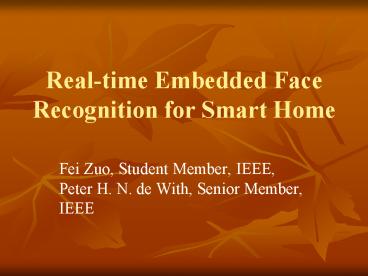Real-time Embedded Face Recognition for Smart Home - PowerPoint PPT Presentation
1 / 32
Title:
Real-time Embedded Face Recognition for Smart Home
Description:
Real-time Embedded Face Recognition for Smart Home ... We propose a two-step coarse-to-fine feature extractor. 1.Edge Orientation Matching (EOM) ... – PowerPoint PPT presentation
Number of Views:134
Avg rating:3.0/5.0
Title: Real-time Embedded Face Recognition for Smart Home
1
Real-time Embedded Face Recognition for Smart
Home
- Fei Zuo, Student Member, IEEE, Peter H. N. de
With, Senior Member, IEEE
2
Introduction
- Consumer electronic devices can sense and
understand their surroundings and adapt their
services according to the contexts.
3
Advantageous of face recognition
- Nonintrusive and user-friendly interfaces
- Low-cost sensors and easy setup
- Active identification
4
The challenges in consumer applications
- Large variability of operating environments (e.g.
illumination and backgrounds). - Processing efficiency with low-cost consumer
hardware. - Nearly unconstrained capturing of facial images.
5
ARCHITECTURE OVERVIEW
- The embedded HomeFace system consists of
- kernel component
- Performing the face detection/recognition.
- interfacing component
- Providing a uniform interface to different
hosting devices.
6
Kernel component processing pipeline
- Face detection ( attention capture )
- Feature extraction for face normalization
(preprocessing for classification) - Face identification
- Pipeline can be executed on the centralized mode
or the distributed mode
7
Processing flow
8
Image processing algorithm architecture
9
FACE DETECTION
- Using a detector cascade to build a face detector
that is highly efficient and robust - Advantages of detector cascade
- 1. Various image features are used
- 2. Largely reduces the overall computation
- cost
- 3.Retaining high detection accuracy.
10
Color-based face detector
- Coarsely locating potential facial regions by
using - color space from a condensed
skin-color cluster. - Fitting a convex hull to the skin-color cluster
in the - plane.
11
Color-based face detector
- Apply a binary majority filter as a
post-processor to smooth the segmentation result
12
Geometry-based face detector
- Algorithm 1 The geometry-based face
verification. - 1. Generate the vertical profile of the candidate
region - 2. Select local minima of the profile as
candidate vertical locations of eyes and mouth.
If no proper minima are found, return non-face - 3. For each candidate vertical location, a
sliding window is applied to search
horizontally for the most probable eye-pair (or
mouth). The average region intensity is used as a
fast evaluation criterion. If the lowest average
intensity is above a threshold, return non-face - 4. Check whether the selected feature group (eyes
mouth) forms an approximate equilateral
triangle. If not, return non-face.
13
Geometry-based face detector
14
Learning-based detector
- For the final detector in the cascade, a
neural-network-based(NN) detector is used. - Its purpose is the final verification of facial
regions
15
Facial feature extraction and face normalization
- The direct use of it will potentially lead to
identification failures. - We propose a two-step coarse-to-fine feature
extractor - 1.Edge Orientation Matching (EOM)
- 2.H-ASM (an enhanced version of ASM)
16
Feature estimation by EOM
- Using 33 Sobel edge filter
- Edge-Strength image ( ES )
- Edge-Orientation image ( EO )
17
Feature estimation by EOM
- Matching function between two image regions P1
and P2 is defined as - Using the average ES and EO as a template, a
multiresolution search is performed over the
detected facial region for the position and scale
yielding the best match
18
Feature estimation by EOM
19
Deformable shape fitting by H-ASM
- 1) Facial feature model with enhanced Haar
textures - 2) Fast computation of Haar textures
- 3) Haar feature selection
- 4) Haar feature weighting
- 5) Feature extraction by H-ASM
20
Facial feature model with enhanced Haar textures
- Build a facial feature model as an ordered set of
Nf feature points.
21
Facial feature model with enhanced Haar textures
22
Fast computation of Haar textures
- Haar decomposition mainly involves summations of
pixel sub-blocks, which can be efficiently
computed by using two auxiliary integral images - The illumination normalization for each block (by
zero mean and one standard deviation) can be
conveniently integrated into the computation of
Haar coefficients.
23
Haar feature selection
24
Haar feature weighting
25
Feature extraction by H-ASM
- From the initial estimation of the feature
position, an initial shape model can be overlayed
to the real image
26
Face normalization
- Using an affine transformation to warp an input
face with varying scale, position and pose to a
standard frame. - feature locations are , where
- , and the feature locations of a
standard face are ,
27
Face Identification
- In space F (Linear Discriminant Analysis)
28
Face Identification
29
EXPERIMENTAL RESULTS
30
EXPERIMENTAL RESULTS
31
EXPERIMENTAL RESULTS
- Database composed of 25 people
- Each person has 4 to 8 sample pictures
- Test under a variety of environments
- HomeFace system achieves a total recognition rate
of 95. - 3-4 frames/second processing speed on a P-IV
PC(1.7GHz) in centralized mode
32
EXPERIMENTAL RESULTS































